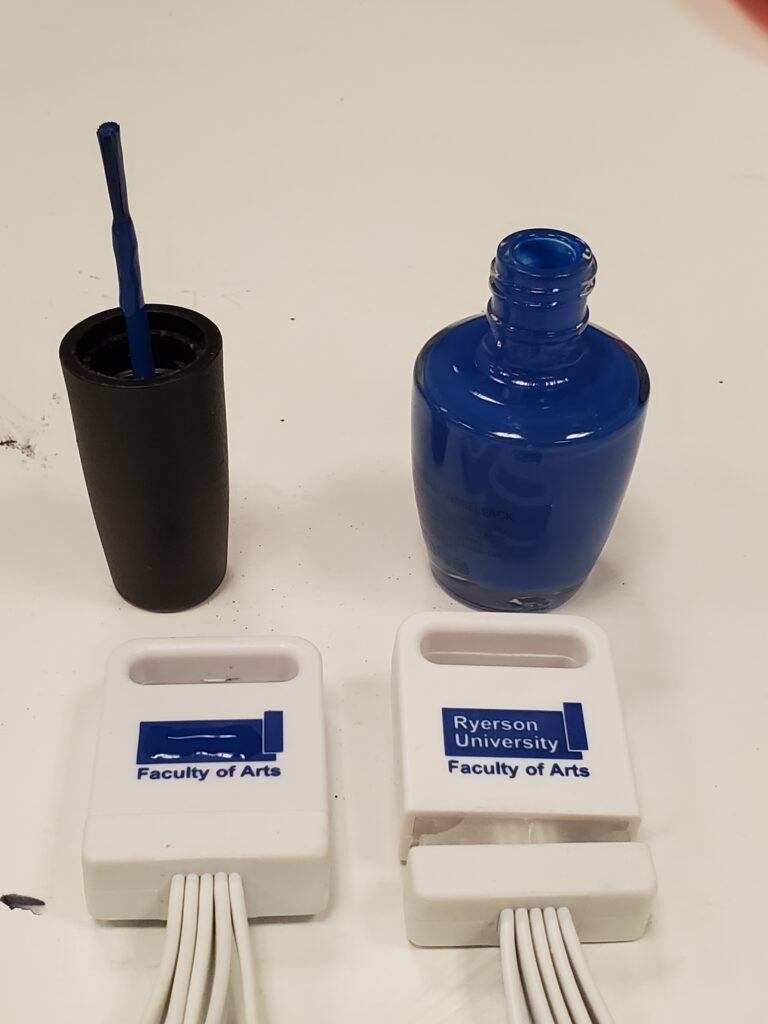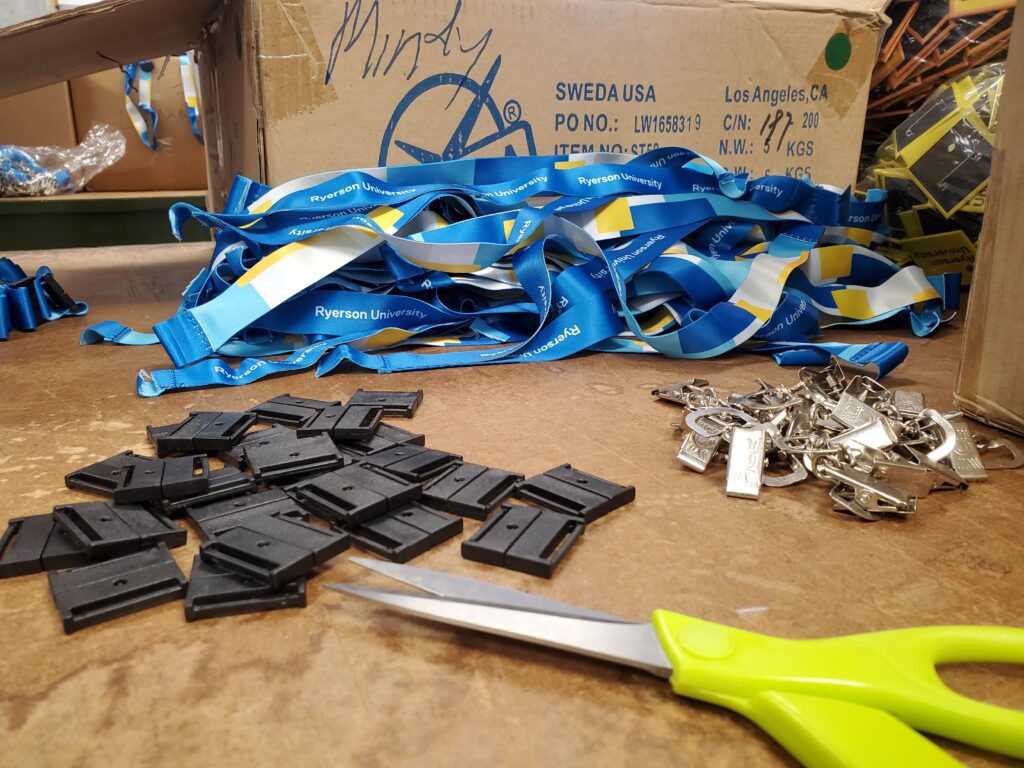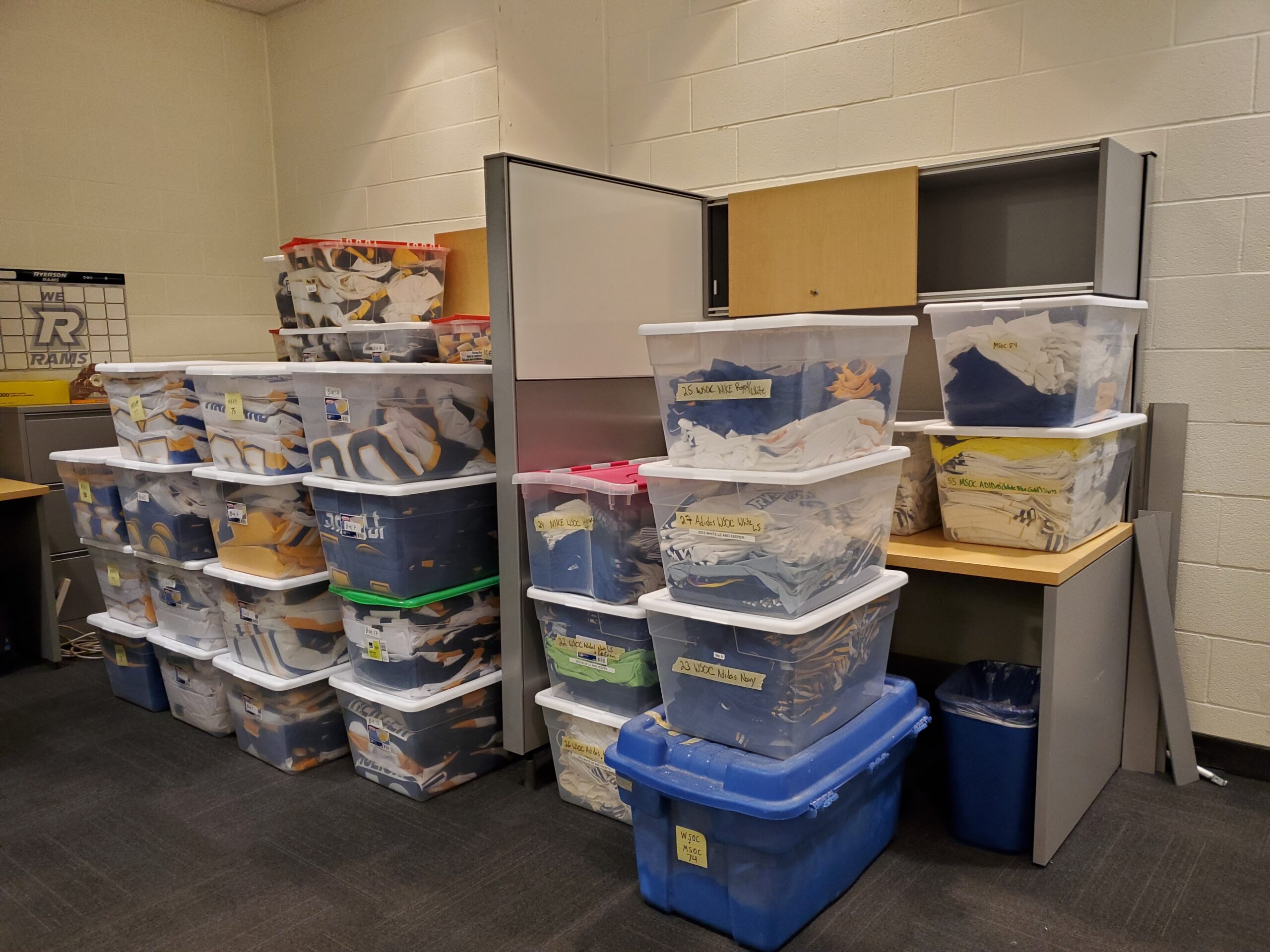Toronto Metropolitan University: Branded Materials Transition Project
Background
In August 2021, the Board of Governors of Ryerson University committed to implementing all 22 recommendations from the Mash Koh Wee Kah Pooh Win, also known as the Standing Strong Task Force (SSTF), including the recommendations to rename the university, reconsider the university mascot and athletic team name.
In April 2022, the university was renamed Toronto Metropolitan University (TMU) to align with the institutional values and aspirations for the future- intentionally diverse and inclusive, dedicated to excellence, respectfully collaborative, and champion of sustainability.
At this time, the Athletics and Recreation Department (Ath & Rec) embarked on the task of changing all team uniforms and gear to reflect the new identity, resulting in a collection of materials that were branded with Ryerson Rams and thus, no longer usable. Gina Vaccaro, Manager of Finance and Strategic Operations of Ath & Rec, proposed a sustainable solution, and under their guidance, it was decided that all items affected by the name change should not be considered waste and be diverted from the landfill wherever possible.
This posed an opportunity for all items to be transitioned- reused in a suitable manner, repurposed/upcycled, or recycled. Following this decision, Narishdath Maraj (Strategic Operation Project Administrator, Ath & Rec), a TMU Fashion alum with experience in post-consumer fashion and textile waste reduction was brought on to oversee the transition of all Ryerson Rams items.
In May 2022, under the leadership of Vaccaro & Maraj, and TMU Next Chapter, this ‘Transition Initiative’ was implemented across the entire university, aimed at diverting all Ryerson-branded items- this became the Branded Materials Transition Project (BMTP). The BMTP is committed to the creative and responsible transition of Ryerson-branded items with the goal of being sustainable and localized in our efforts of keeping these items out of landfills. As of April of 2023, the BMTP is still operating as an extension of the Record Retention & Space Transition Project (RR&STP).
Solution Finding
Branded materials were collected from 220 campus areas/units, which fell into multiple waste streams (e.g., wood & paper, metals, plastics, textiles, ceramic & glass, etc.).

To tackle the vast amount of materials collected, extensive research was done to determine the best (most localized and/or environmentally friendly) method to transition each type of item. A database was created of all the ways to reuse or upcycle/recycle every type of material. Below are examples of the types of solutions TMU utilized for this project.
Sustainable Solutions
The first strategy was to determine a variety of methods to ensure that items could continue to be used as they were originally intended to, or to be reused internally for a different purpose. Items that could not be reused were then upcycled by breaking down items into their component materials for resume elsewhere. Items or components that could not be reused were then recycled.
Reuse
1) Acetone-based nail polish remover proved to be very effective at removing branding on items such as plastic water bottles, metal to-go cups, plastic locks, and other items that branding was printed on. Additionally, paint and nail polish were used to cover the old branding on other items such as plastic water bottles, USB drives, screen-printed t-shirts, and tote bags. In many cases, the old logo was removed/covered, leaving the departmental name, which allowed the items to be returned to their original department for use.

2) Items were also donated to community organizations (e.g., Toronto Homeless Connect, The Younge Street Mission, The TMU Theatres, Fashion organizations, High Schools, etc.).

3) Some items were disassembled and sent back to the manufacturer. For example, 20,000 lanyards were dismantled, returning the metal bits to vendors for reuse, the plastic clips were donated to an internal Stuff Swap and through PPG’s Material Exchange program, and the printed ribbons were used by TMU’s School of Fashion for reuse.
4) A pop-up shop was created for local artists, designers, and other community creatives to swap materials for projects. Creatives were asked to bring an item to exchange to promote diversity of materials.
5) Alumni student-athletes were given the chance to purchase their former jersey as a keepsake. In total, 75 jerseys were purchased.
Upcycle
6) Over 20 Alumni fashion students were given the opportunity to design for the Upcycle Gear Fashion Show. A collection made of upcycled branded textiles and other materials into fashionable articles of clothing was presented by student-athletes and the University’s Executive Team, including the President and Vice-Provost, Students.

The collection was auctioned, with proceeds from the jersey sale and upcycled fashion collection was used to create the TMU BOLD Equity and Inclusion Award.
Recycle
7) Lastly, items were donated to recycling/reuse partners such as Waste Reduction Group, Souvenir Canada, and Norwich Plastics.
Key Metrics
From April 2022 to April 2023, a total of 11,060 kg of waste was diverted from landfill using a combination of reuse, recycling, and upcycling strategies. This number represents 2,613 kg of apparel, 915 kg of Rams uniforms/gear, 4,731 kg of merchandise and swag, and 2,800 kg of paper products.
This work was carried out by two full-time staff members, 8 student employees, 12 staff volunteers, and with the support of TMU’s Facilities Management and Development team.
Lessons Learned and Moving Forward
When asked what this project has taught them, Gina and Narishdath reflected on the impact of swag and conscious purchasing. “When you think about it, it is not sustainable to continue purchasing so many different types of office supplies or branded items. The new generation of students doesn’t care for the waste. It just ends up branding the landfill.” When we focus on lengthening the lifecycle of a product and promoting a circular economy, there ends up being less waste, students and faculty can rely on good quality and lasting supplies, and the institution saves money.
As an extension of the Branded Materials Transition Project, Gina and Narish are currently working on the Record Retention and Space Transition Project (RR&STP), which is focused on a sustainable and equitable transition of office spaces to a hybrid-friendly model. This includes sustainably cleaning out and disposing of materials (e.g., filing cabinets, electronics, paper files) while complying with record retention schedules and reducing and preventing waste accumulation.
A Circular Economy for Textiles Program is currently under development at TMU, as a collaboration with The Creative School, the Fashion Zone, the Design Fabrication Zone, and the Athletics and Recreation Department.
Partners in Project Green’s Material Exchange program facilitates the exchange of material generated within our stakeholder community (businesses and non-profit groups) to divert waste from landfill, move towards a circular economy, and strengthen community ties. To learn more about the Material Exchange program, please contact Darlene.Coyle@trca.ca

